Diurnal Heating Over Geologic Time
Since its formation 4.5 billion years ago, Earth has been continuously changing. Sometimes the changes are cyclical, sometimes they are slow and irreversible, and sometimes they are episodic and dramatic. How has Earth’s diurnal heating changed over time as:
-
- The Sun increased somewhat steadily through time?
- The Earth’s rotation slowed?
- Plants evolved on land?
- Humans have altered the land cover by removing forests, paving surfaces, and building cities?
Sun’s Radiation Increasing over Time
Astronomers have been studying stars with a variety of technologies for a long time, and they have developed models of how different types of stars evolve. When we look at stars, we are viewing the light that came from the star at some time in the past. For our Sun, the light we saw was first emitted from the Sun’s surface roughly 8 minutes ago, and each photon took just under 500 seconds to travel to Earth. If a star were one light year away, then the light we see was emitted a year ago. The farthest known star discovered so far is 9 billion light-years away. Since there are so many stars at varying distances from Earth, we have data about stars developing over billions of years. Based on analyzing the stars of different ages, astronomers have created the Hertzsprung-Russell Diagram, which maps out the patterns of changes in stars over their lifetime.
Our Sun was considerably dimmer when it formed 4.5 billion years ago, emitting roughly 25% less radiation than today’s Sun. There is considerable research into determining why the young Earth had liquid water present with so much less sunlight, and this is called the ‘faint young Sun paradox.’ To understand most of the findings and proposed mechanisms that kept water liquid on Earth for life to evolve, revisit these links 1 and 2 after exploring more of Earth systems.
Will there be a time when we have too much sunlight? Yes, but lucky for us, our Sun is getting warmer and brighter very slowly. In about a billion years, Earth will become uninhabitable by the increasing amounts of radiation emitted from the Sun.
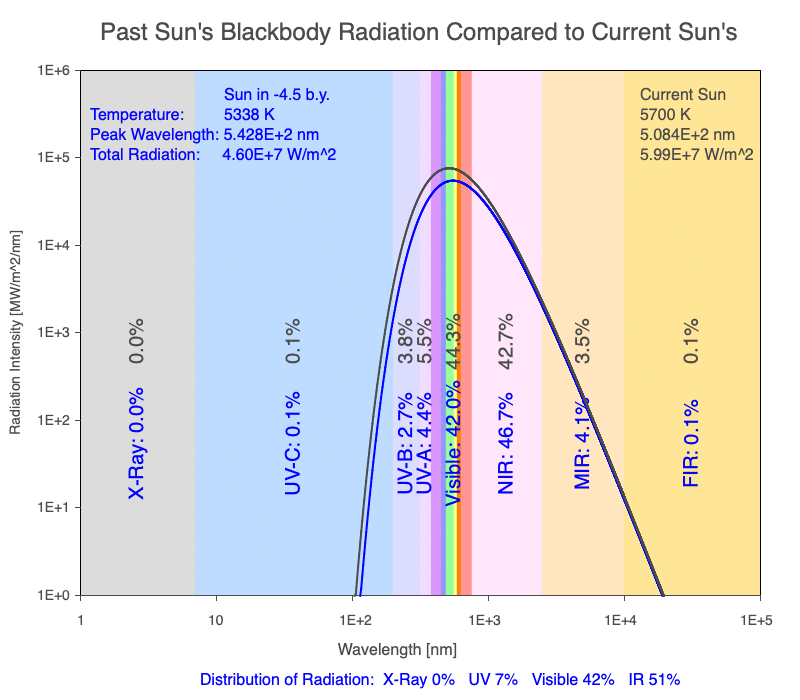
Above is an animation of how the thermal radiation emitted from our Sun (blue line) has changed from its origin 4.5 billion years ago until the present and how it will continue to evolve as it nears its end in 4.5 billion years from now. For reference, the dark gray line represents the current Sun’s spectrum. The Sun has warmed since it formed and will continue to do so. A warming star emits higher amounts of radiation with a more significant percentage in shorter wavelengths.
Since Earth has only had plants living on the land for the past 470 million years (which represents just over 10% of Earth’s existence!), we used granite, a common igneous rock found on continents, as the surface material in the following three animations.
In the animation showing how diurnal heating changed as the Sun’s temperature increased in 100K increments, the starting Sun temperature was 5300K, which was similar to when the Sun formed. The final temperature of 6000K is just a bit hotter than today’s Sun (5700K).
If all other conditions remain the same, increasing the incoming solar radiation will increase the amount absorbed by the granite, which warms the rock even more. Hence, it emits considerably more thermal radiation. The daily range of surface temperatures will become much more extreme!
Color Key for Diurnal Heating Graphs
- Red Line = Amount of the Sun’s radiation absorbed by surface material
- Blue Line = Amount of thermal radiation emitted from the surface material
- Green Line = Surface Temperature
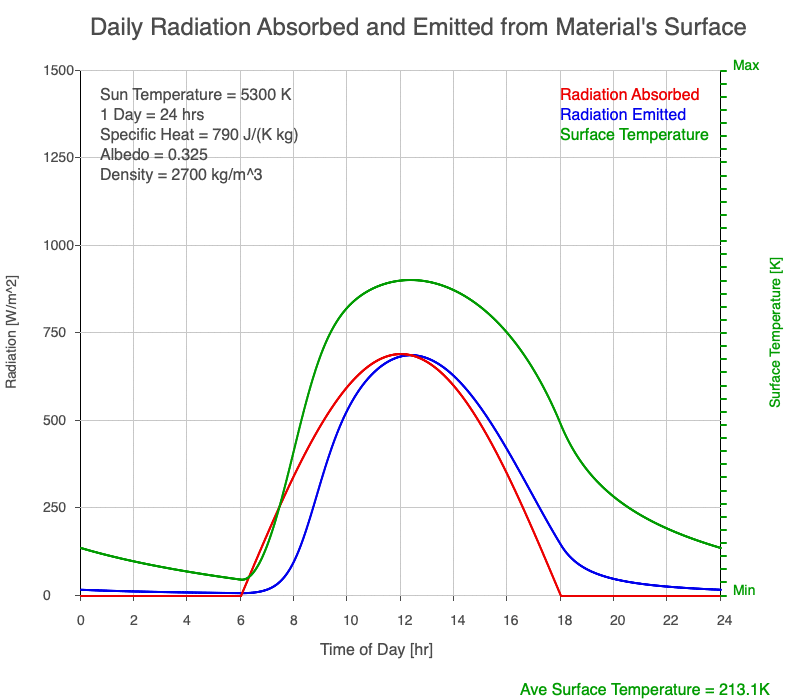
Earth’s Rotation Slowing Over Time
Our Moon dramatically impacts our planet in so many beneficial ways, but one could debate that slowing down our rate of rotation is not necessarily positive. When Earth formed 4.5 billion years ago, scientists estimate that a day lasted only 6 hours (we completed a rotation that quickly!). The gravitational pull between the Moon and Earth creates tides in our oceans, which helped life to evolve on Earth and encouraged a far more diverse array of lifeforms. Still, the friction of large mounds of water sloshing across ocean basins has consistently slowed the Earth. Note that we also have tides of our solid crust on Earth!
How does the slowing down of Earth’s rotation affect its diurnal heating? Looking at most of the graphs of diurnal heating, particularly the emitted thermal radiation from the Earth’s surface and the temperature of the surface material, it is not symmetric compared to the incoming solar radiation.
As one would expect, longer days allow for more solar radiation to be absorbed, so the maximum daily temperature increases, but the minimum daily temperature decreases even more. Hence, the average temperature decreases with longer days.
Caveat: This is a simple radiation model. Notice that the average temperature is well below freezing (273K), which we would not see on present-day Earth with a 24-hour day! Consider the trends of the data, not the actual values given by this model.
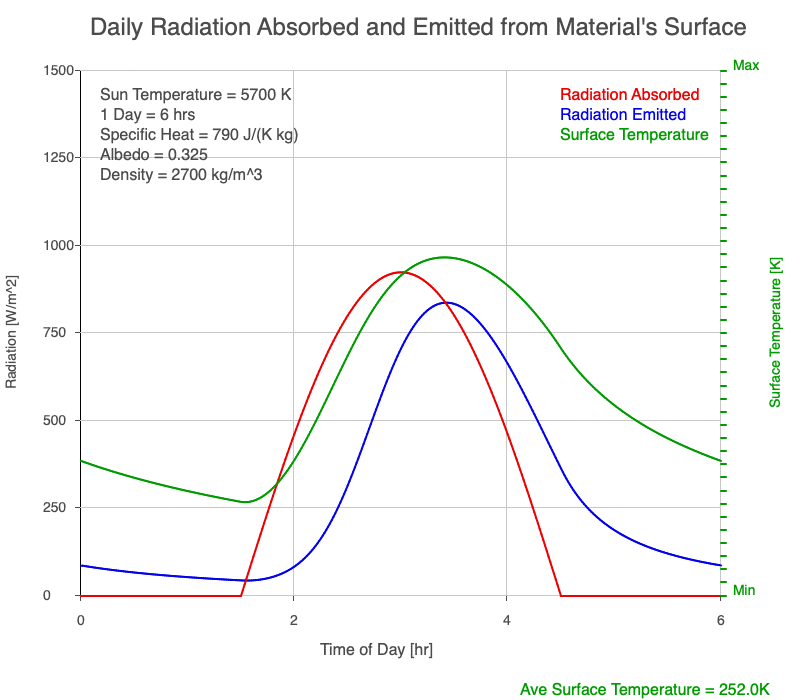
As with the animations of diurnal heat above and below, the surface material is granite, a common igneous rock found on continents.
Data on Earth’s rate of rotation through geologic time were estimated from the graph created by Arbab I. Arbab.
Combining Effects of Earth’s Rotation Slowing and Sun Warming Over Time
The early Sun was so dim that scientists have not found any definitive mechanism(s) where the Earth would be warm enough that the oceans could exist as a liquid rather than ice. This dilemma is known as the faint young Sun paradox. There are many proposed mechanisms, but none have been proven yet.
Combining the two effects — a colder Sun and a more quickly spinning Earth 4.5 billion years ago, followed by the warming of the Sun and a slowing of Earth’s rotation — produce a more moderated response of diurnal heating. Average temperatures were warmer on early Earth based on these factors (NOTE: there are many more factors to consider!). Still, peak daily temperatures did not increase as significantly compared to the warming Sun trend alone.
Caveat²: Did we say this is a simple radiation model? Models of the effect of the rate of rotation for a planet without an atmosphere on average daily temperature and for early Earth verify theses trends.
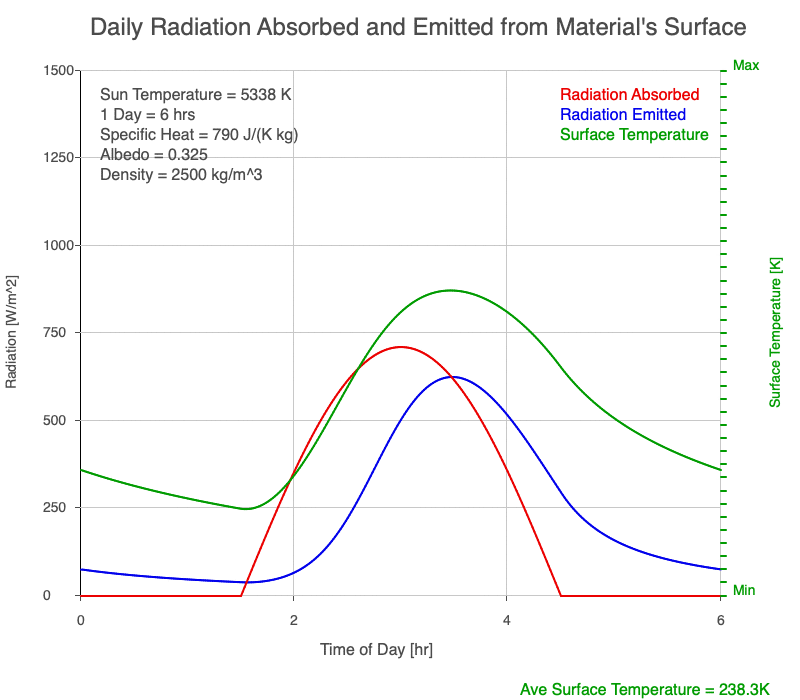
Including Conduction in the Diurnal Heating Model
When I was a kid playing in the sand, I marveled at how cool it was when we dug beneath the surface, but I also noticed that it was colder during the morning hours. While working on a project at the Cape Cod National Seashore in early April many years ago, I had some spare temperature data loggers with me, and I remembered this observation. So I dug a narrow hole and placed the data loggers at one-inch intervals with depth. Sadly I had to leave shortly at 3:30 PM, but the following graph shows how the temperature increased with depth from 9:30 AM until 3:30 PM.
As the Sun’s radiation warmed the surface of the dune, conduction slowly warmed the sand with depth. At night, the radiational cooling of the sand at the surface would have reversed the direction of the conduction. Conduction from below would slow the rate of nighttime cooling of the surface of the dune.
The simple model diurnal heating model used on this page does not include this type of complexity involving conduction, so although the trends may be useful, the values are not representative of what we would find in nature.
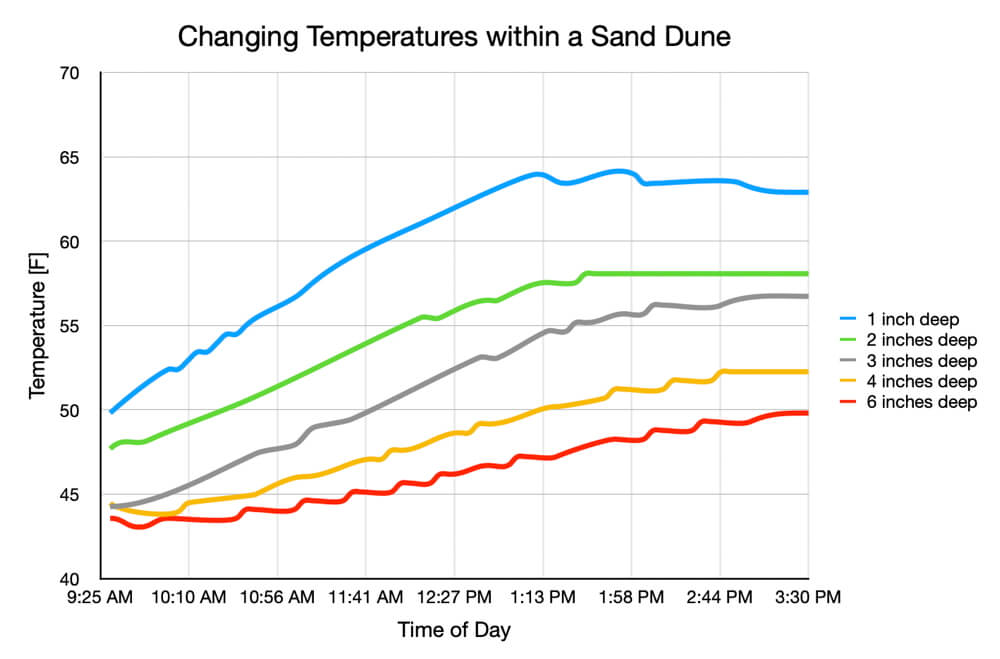
Graph of the temperatures within a sand dune in early April at the Cape Cod National Seashore. Data loggers were placed at one-inch intervals with depth and recorded temperatures from 9:30 AM until 3:30 PM.
Evolution of Land Plants
After nearly 4 billion years of being barren, rocky (and possibly sand dune-covered) continents, land plants evolved! This new land cover changed the planet considerably, for example, by dramatically changing the radiation budget on land. Below are the graphs of diurnal heating of a land surface covered by plants and a land surface consisting solely of exposed granite, a common igneous rock found on continents. Land plants rapidly moderated the range of diurnal heating, which would have made conditions less extreme for the land animals that eventually evolved.

Diurnal heating over a land surface covered by plants 470 million years ago when the Sun was about 40K cooler than today and a day was 21 hours long.
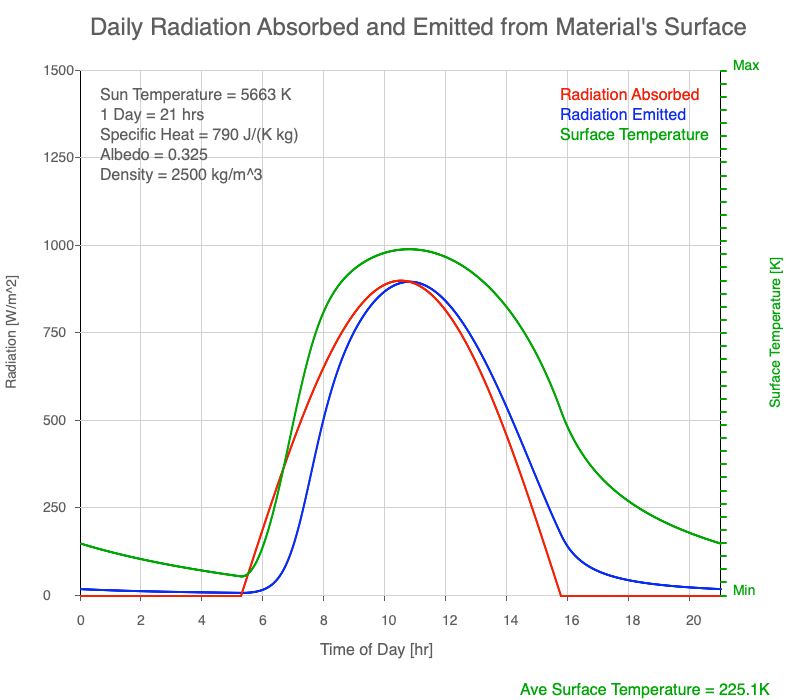
Diurnal heating over a surface of granite (a common continental rock) 470 million years ago when the Sun was about 40K cooler than today and a day was 21 hours long.
Impact of Humans
All living organisms impact their environment, and all compete to live, which amplifies how much they alter their surroundings. The earliest plants that formed on Earth changed the planet dramatically by eventually creating an oxygen-rich atmosphere. Without them, oxygen-breathing animals could not have evolved. Humans are an exceptional presence on Earth – we don’t just compete to live; we alter the world to make our lives more efficient, comfortable, and profitable. Humans have created technologies that change our environment at ever-increasing rates. For example, we are altering our local diurnal heating patterns through paving and building. When roads and buildings replace vegetated areas, we create urban heat islands. Compare the two diurnal heating patterns that follow. It is no wonder why these are “heat” islands!
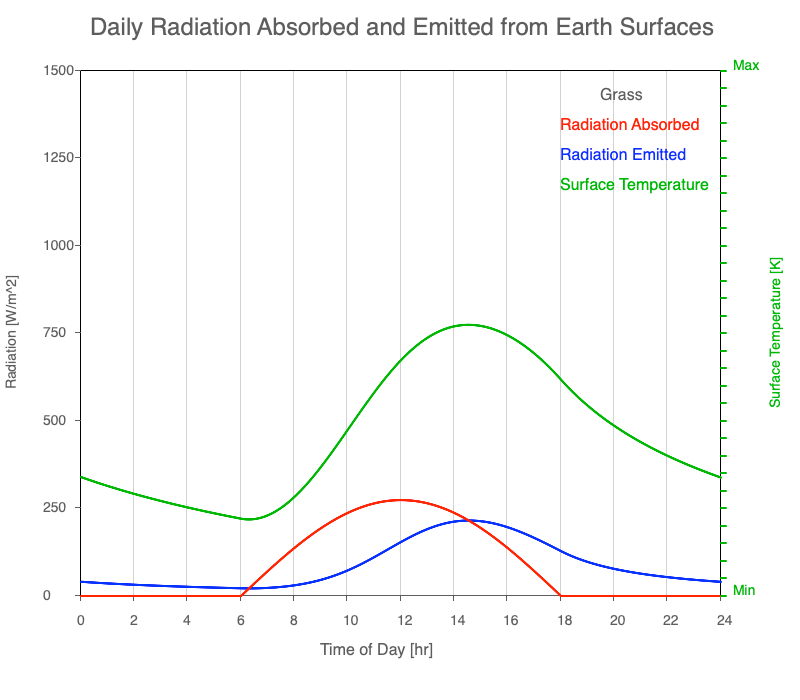
Diurnal heating over a land surface covered by plants with a present-day Sun temperature and a 24-hour day.
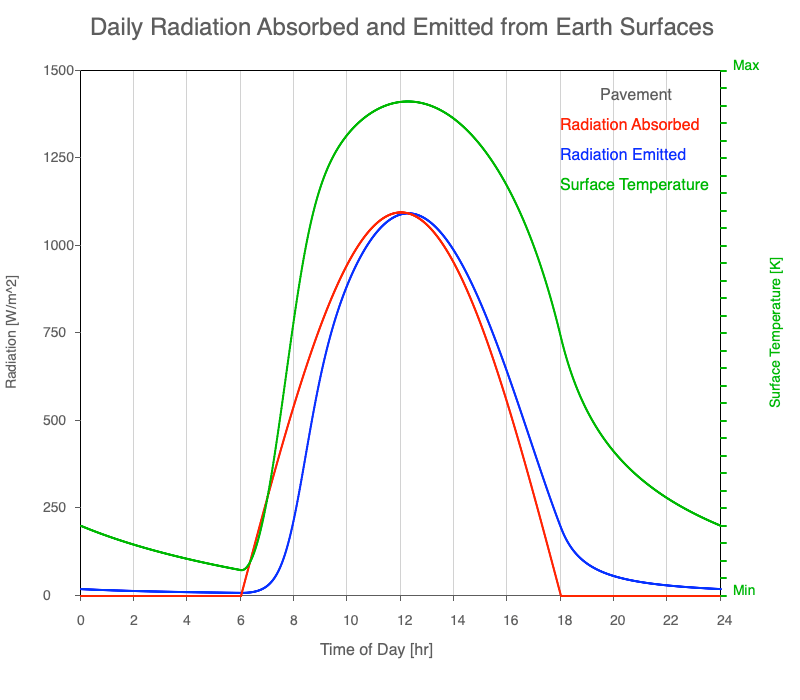
Diurnal heating over a land surface covered by pavement with a present-day Sun temperature and a 24-hour day.
Blackbody Radiation Desktop Software
Use the Blackbody Radiation software to explore how Earth’s radiation budget and diurnal heating has changed over geologic time. Relate the amounts and types of radiation emitted to Earth system processes, including how the Sun has changed and will change over billions of years. To help, here is a document of key terms.
Big Ideas
-
Since its formation 4.5 billion years ago, Earth’s diurnal heating patterns have been changing over time as:
- The Sun has warmed, which increases the amount of its thermal radiation reaching Earth.
- The Earth’s rotation has slowed, so hours of daylight have increased as did the hours of darkness during a day.
- Plants evolved on land, changing the reflectivity and specific heat of large portions of land surfaces.
- Recently, humans have altered the land cover by removing forests, paving surfaces, and building cities.

0 Comments